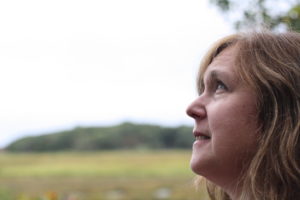WELLFLEET — In September Melissa Lowe Cestaro became the director of Mass Audubon’s Wellfleet Bay Wildlife Sanctuary. She succeeds Bob Prescott, who is retiring after nearly 40 years in the post. Melissa is an environmental educator and came to the Audubon from the Center for Coastal Studies in Provincetown. The Independent asked Cestaro about her history with the natural world, and how she sees the role of the sanctuary moving forward.
Elspeth Hay: What are your earliest memories of the natural world?
Melissa Lowe Cestaro: I grew up in a rural community outside Worcester in Central Massachusetts in the 1970s. I spent all of my time outdoors in the woods behind my house. The forest was filled with mountain laurel and rhododendrons and when I was young I spent hours making forts in the labyrinths under their branches.
As I got older — maybe around 10 — I would hike for hours alone with my dog. This was pre-cell phones, and my parents were working, so they didn’t know where I was. There was a huge network of trails and I would come home, drop my backpack, go out and come back three hours later. Today this would be unusual, but back then it was everyday as a kid, no big deal.

EH: What changes in the natural world have you noticed since your childhood?
MLC: I’m a big raptor fan — hawks and owls especially. I remember in fifth grade someone came into our classroom to talk about DDT and the impact on eagles and other birds of prey. Since then with these birds there’s been a great success story. We’re now seeing ospreys in huge numbers on the Cape, and ravens and even eagles coming back here.
At the same time we’re now learning that we’re losing songbirds at an alarming rate. We’re starting to realize we’re looking at a much bigger issue than just a few endangered species. It’s daunting.
EH: Right, a study published this September in Science estimates North America has lost 3 billion migrating birds over the past 50 years, or 29 percent of 1970’s population. In this age of climate crisis and accelerating extinction rates, what role do you see sanctuaries like the Audubon’s Wellfleet Bay playing in our communities?
MLC: These spaces are true sanctuaries on so many different levels. In my mind our space offers a retreat for people, a place to come to feel more grounded and peaceful.
It’s also a social space for people to gather and work towards change. It’s a space where you can get perhaps inspiration — we have a platinum certified green building, a solar array, and are almost net zero when it comes to energy use. It’s a good place to get an understanding of how biological and ecological processes work, so that we can understand our individual and collective choices about how we live on this Earth.
Finally, it’s also a sanctuary for wildlife experiencing impacts somewhere else. In that way it becomes a very important space. I think it serves as an example of what we can all do in our back yards to create places of refuge — it doesn’t have to be solely this space.
EH: What’s a conversation about our relationship to the natural world you don’t hear much, that you wish more of us were having?
MLC: I’m an American literature major, so my background is in studying how people perceive the natural world, how that reflects cultural values, and what shifts those values.
We were in Maine recently and met people who asked where we were from. When we told them the Cape they said, “Oh, we just saw that Chronicle episode about sharks!” It’s such a focus.
We’re at this really interesting place where we’re actually seeing some rebounds — not just sharks and seals but also raptors and other species. I’m interested in how we adapt to that. It’s a reminder that we share this landscape, and I want us to think critically about that rather than espouse one thing or another. I find the human dimension of wildlife fascinating.
